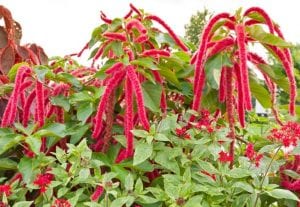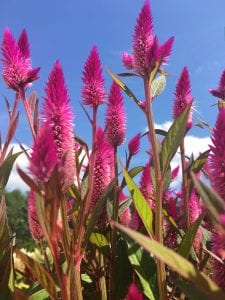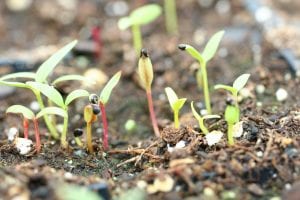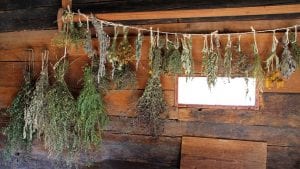This article first appeared in The Times-Herald Record on Saturday, March 30, 2019 in the Home & Garden section.
By Joe Gregoire, Orange County Master Gardener, Cornell Cooperative Extension Orange County
I love mushrooms and heard that Shiitake mushrooms can be grown on logs in my backyard. Do you know anything about that? – Phil from Campbell Hall
Happy Spring, Phil. Yes, I do know something about growing mushrooms on logs. In fact, Cornell offers a weekend course they call “Camp Mushroom” that is a great way to learn a lot on this subject. I attended the course a few years ago and have been enjoying fresh picked shiitake mushrooms ever since. A warning to you though, this is something that requires a lot of patience, so if you don’t mind developing something over a 12-month period, then read on.

Shiitake mushrooms gathered off fallen logs have been the most popular mushroom in Asia for centuries. The origins of shiitake cultivation have been traced back thousands of years to China and Japan. People often found these mushrooms growing on downed “shii” trees (this is where the mushroom got its name). They would take the mushroom-clad logs, place them next to logs without mushrooms and simply wait for the wind to disperse the spores. Thankfully, since then, a lot of research in Japan and China has gone into shiitake-growing techniques, and we don’t have to wait for the wind anymore. Shiitake is the second most produced mushroom in the world, following the common button mushroom and contribute about 25% of total yearly production of mushrooms. Commercially, shiitake mushrooms are typically grown in conditions like their natural environment on either artificial substrate or hardwood logs, such as oak.
There are several steps to growing shiitake mushrooms on logs. The first step is purchasing an inoculum which contains the mushroom cells (called mycelium) that will produce the mushrooms. It most commonly comes in 2 forms – inoculated sawdust, and small wooden dowels that have been inoculated with mycelium.
The next step is obtaining logs for inoculation. There are many ways to obtain logs. You can cut your own as you maintain your forest and landscape by thinning trees or pruning large branches. Or you can contact a local arborist or tree service to see if they can sell you some logs instead of feeding them into a chipper. Existing commercial shiitake growers in the area may also be able to sell you logs from their own supply.

Shiitake grow best in Oak or Maple trees. White Oak and Sugar Maple are the proven best producers, with Red Oak a close second. Red Maple is also considered good. These dense hardwoods provide the shiitake mycelium a long-lasting food source, which can enable the log to continue fruiting for 3-4 years. Also, the thick bark layer and durability of the bark on Oak and Maple helps maintain moisture levels in the log and the health of the mycelium.

Logs are best harvested while dormant. The bark is tightest during this time of year and timing allows for colonization to be complete in time for the earliest fruiting 12 months later. Avoid harvesting during spring bud break as bark can slip off during this growth phase of the year. Select logs that are 4 to 6 inches in diameter about 3 feet long. Thinner than this will have a shorter useful lifespan and larger than this will be very heavy. Use only healthy living trees. This is important in order to ensure that your shiitake spawn is the only species growing in the log. Let logs season for about 2 weeks after harvest. It’s conventional wisdom that this seasoning time allows the natural fungal inhibitors in the living tree to dissipate. Complete the inoculation process within 2 months to ensure logs don’t over dry – 35% moisture content is the ideal – and to avoid competing fungi colonization.
A quick word on safety.
It is never safe to pick and eat just any random mushroom you find. Some can make you sick and some can kill you. It is important to understand a few safety tips to ensure the mushrooms you grow and harvest are safe.
By inoculating only logs from healthy living trees, you give your shiitake spawn a big head start in colonizing the log. Shiitake are primary decomposers, so they only will grow in freshly cut wood, not already decomposing wood where other mushroom strains may have already colonized. If you’re not sure if a mushroom on your log is a shiitake, consult a mycologist or other specialist. Two good local sources are Mid-Hudson Mycological Association and Catskill Fungi.
So now you have your logs – time to inoculate them with shiitake spawn. Inoculation is a 3-step process:
Step 1 is drilling holes into the logs in a diamond pattern in 6” intervals in rows 2” apart. The drill bit you use needs to be sized to fit the dowel or the sawdust spawn inoculation tool you’ll be using. 5/16” for dowel and 7/16” for sawdust. For beginners, I recommend using dowels as only a hammer is needed to pound them into the holes and you avoid buying an expensive inoculation tool.
Step 2 is filling holes with spawn, which is simple with dowels that are pre-inoculated with shiitake mycelium and just need to be tapped into the holes.
Step 3 is to dab melted cheese wax over the filled holes. Cheese wax is best as it stays pliable for the several years you’ll be harvesting from the log. The wax replaces the bark and helps maintain moisture in the log. No need to apply wax to the end of the logs.

Once the logs are filled and waxed, its just a matter of letting the logs sit for 12 months in a shaded damp space to mature. The mycelium you placed in the logs will grow during that year and when the weather warms above 60 degrees next spring, shiitake mushrooms will begin to fruit from the log. And the great thing about shiitake is that you can force them to fruit by soaking the mature log in cold water for 24 hours, which will cause fruiting within about 5 days. With practice, one can average ¼ to ½ pound of fresh shiitake per log and, after a resting period of 7 weeks, that same log can be forced continue with the same log for 3-4 years until the mushroom has completed the primary decomposition of the log.
Cornell provides a wealth of additional information and tips on this subject, so if you’re interested in learning more, visit http://blogs.cornell.edu/mushrooms/
Here is a link to “Best Management Practices for Log-Based Shiitake Cultivation in the Northeastern United States” put together by Cornell University and the University of Vermont.







